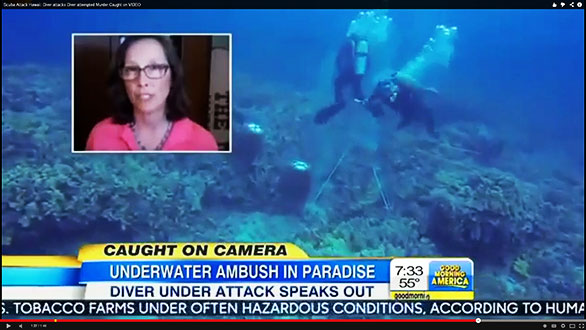
Hawaii’s aquarium fishing controversies became national news when anti-fishing activist Rene Umberger was attacked by diver Jay Lovell who was collecting Yellow Tangs. Screen image from ABC Good Morning America broadcast.
Sea Shepherd Diver Rene Umberger and AQ fisherman Jay Lovell in an unprecedented physical clash at 50-feet down
“Attempted Murder!” she says.
“Self-defense.” his defenders counter.
Special Report to CORAL Magazine by Ret Talbot
When an underwater video surfaced early this week showing an aquarium fisherman rush a Sea Shepherd Conservation Society diver and knock the scuba air regulator from her mouth, it was physical proof that the more-than-decade old battle over Hawaii’s aquarium fishery is far from over.
Even with the best available science showing that the collection of reef fish in Hawaiian waters is sustainable, even with state biologists stating the Big Island fishery is amongst the best managed in the State, and even with new rules in place to ensure that the reefs on the Kona Coast of the the Big Island are not overfished and that the corals are not harmed, a vocal faction of the anti-aquarium movement in Hawaii continue to claim the Island’s reefs are being “raped.”
This incident signals another unwelcome escalation in the battle over Hawaii’s largest aquarium fishery. To many outside observers, it’s difficult to comprehend. To nearly every insider, it’s almost too much to bear.
Profound Potential for Conflict
The Big Island is Hawaii’s largest island and its west coast is home to the State’s largest aquarium fishery. To be clear, the Big Island is not Oahu or Maui. It’s not uncommon to hear people reference the Big Island as “the last frontier” or “the Wild West”—home to a certain wildness evidenced by active volcanoes, a snow-capped mountain and fiercely independent-minded people. Many of the Island’s residents live in close association with the natural world both professionally and recreationally. This is certainly the case for the Island’s fishermen, many of whom daily head out in small boats to make a living or just to enjoy a day on the water with family and friends—going holo holo, as a local might say, going no place in particular and just for the joy of being out with nature.
Given the multiple uses, the potential for user conflict in the relatively narrow swath of reef between the shoreline and the drop-off is profound. Nowhere has the conflict been more evident than in the aquarium fishery, which frequently pits the dive community against aquarium fishermen.
By any measure, the aquarium fishery here is small—there were only 61 commercial aquarium permits issued to Big Island residents last year. While the numbers of fishes harvested for aquaria may appear painfully large to the uninitiated—we’re talking hundreds of thousands of animals taken from the Big Island aquarium fishery alone each year—most of these fishes, such as the iconic Yellow Tang, are prolific spawners and, according to fisheries biologists and managers, produce more than enough offspring to sustain the fishery as it is currently operated.
The State, citing the best available science, says the fishery is sustainable. In fact, fisheries managers say the aquarium fishery is one of Hawaii’s best-studied commercial fisheries. Hawaii’s aquarium fishery is often cited as one of the best-studied aquarium fisheries in the world.
Explosive Incident
On Thursday, May 8th, Jay Lovell and Tyron Terazano, two aquarium fishermen, headed out from Honokohau Harbor in a small boat to fish. Both men hold commercial aquarium permits from the State. The boat from which they were fishing was clearly marked as an aquarium fishing boat with both “AQ” letters on the boat and a stiffened “A” pennant flying—a requirement under the current regulations.
Sources at the harbor from which Lovell and Terazano departed that day say that within a short time a second boat left the harbor and headed in the same direction as Lovell and Terazano.
Some who saw the second boat recognized the “Reef Defense” name stenciled on the aft quarter. They recognized the boat as one of several boats allegedly operating in conjunction with Operation Reef Defense, a Sea Shepherd Conservation Society campaign launched in Hawaii almost a year ago to the day.
Up until last week, however, there had not been any reported confrontations on the water between fishers and Sea Shepherd, but what happened on an overcast day in May, 2014, will likely go down as a landmark skirmish in the ongoing battle over the aquarium fishery in the Hawaiian Islands, the most important U.S. source of wild-caught marine ornamental fishes. In the eyes of some, Hawaii has becoming a model for other such fisheries in many island nations of the Indo-Pacific, but for others, it is emblematic of what is wrong with the worldwide trade in aquarium animals.
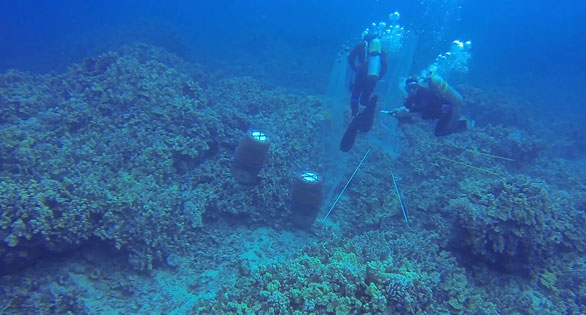
Rene Umberger’s GoPro camera video shows her approach to the fishing site of Jay Lovell and his partner, who were fishing with a net for Yellow Tang. Series of images: Rene Umberger, For the Fishes.
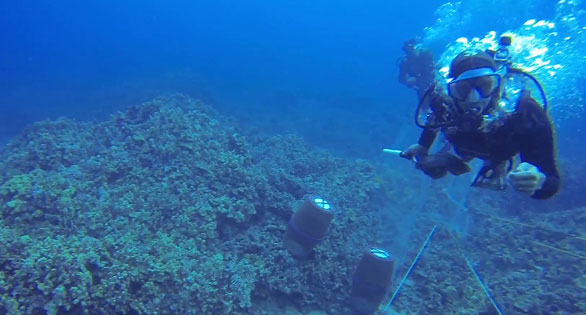
Jay Lovell rushing at Rene Umberger at about 50-feet below the surface. Fishermen’s net poles and holding containers in background below.
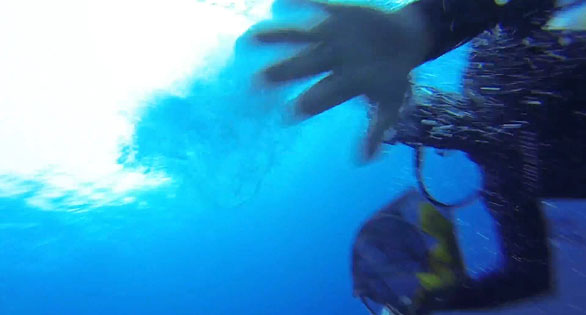
Fisherman Jay Lovell yanks Umberger’s air regulator from her mouth. He retreats with a bag of Yellow Tang still in his hand.
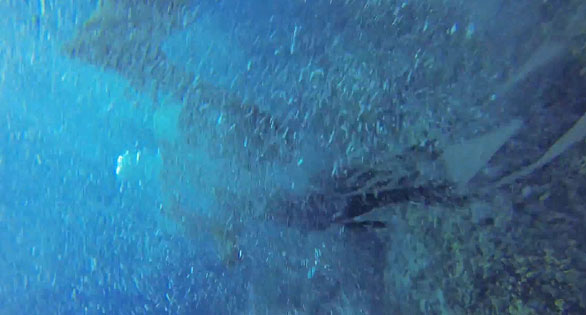
Moment of terror for Umberger. Lovell says that all divers are trained to replace their regulators underwater and that he was “just trying to defuse the situation.” Sea Shepherd spokesperson says a less experienced diver could have died.
Sea Shepherd & Snorkel Bob: A Complex Scenario
The Sea Shepherd Conservation Society, best known for their anti-whaling campaigns that became the subject of the popular Discovery Channel show “Whale Wars,” is an international non-profit, marine wildlife conservation organization. Sea Shepherd’s mission is “to end the destruction of habitat and slaughter of wildlife in the world’s oceans in order to conserve and protect ecosystems and species.” According to a Sea Shepherd spokesperson, “Sea Shepherd uses innovative direct-action tactics to investigate, document, and take action when necessary to expose and confront illegal activities on the high seas.”
Sea Shepherd formally engaged in the debate over aquarium fisheries and the aquarium trade as early as the summer of 2010. In August of that year, Robert Wintner (aka Snorkel Bob), owner of the largest reef sports outfitting business in Hawaii, published a guest commentary on the Sea Shepherd website entitled, “The Dark Hobby; Can We stop the Devastating Impact of Home Aquaria on Reefs Worldwide?” At the time, Wintner was serving on the Sea Shepherd advisory board, and he was introduced in his guest commentary as a “generous Sea Shepherd supporter for more than 15 years.”
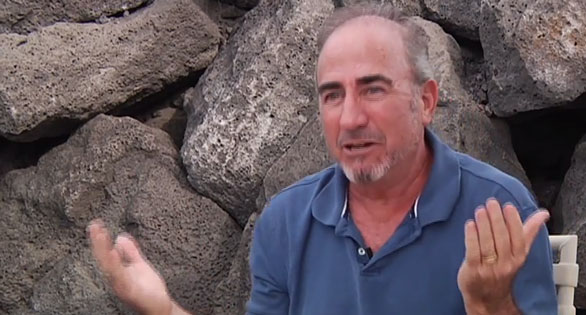
Robert “Snorkel Bob” Wintner in an interview, talking about “my friends, the Cleaner Wrasse.” Image by Carolyn Harding from a You Tube Video (Link below).
“I’ve known Bob for about 15 years,” says Paul Watson, founder and head of the Sea Shepherd Conservation Society. “I know that he is very passionate about protecting reef fish.”
Watson makes it clear, however, that there is a key difference between Wintner’s involvement with Sea Shepherd and his involvement with his own foundation. “He has the Snorkel Bob Foundation,” explains Watson. “I believe he is probably protesting and opposing the [aquarium] industry overall. There’s certainly something to be said for that, but Sea Shepherd does not protest.
“So we should make that clear that there is a distinction between the Snorkel Bob Foundation and Sea Shepherd.”
Wintner is the de facto leader of anti-aquarium trade efforts in Hawaii, and his activities predate Sea Shepherd’s engagement. While Watson is quick to point out that neither protest nor intervention of legal fishing activity is on the Sea Shepherd agenda, both have most certainly been on Wintner’s agenda for many years.
So when Wintner steps aboard a vessel operating in conjunction with Sea Shepherd, which is exactly what happened last Thursday, the situation becomes very complex and certainly has the potential—as the video bears out—to be explosive.
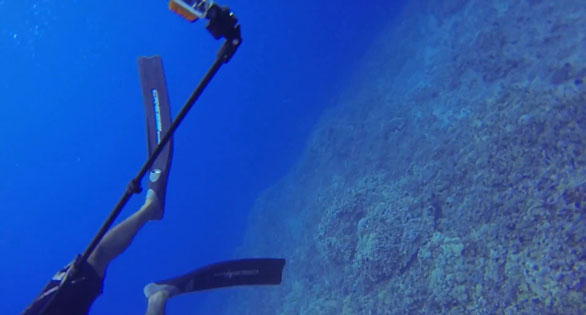
“Just going holo holo,” Reef Defense claims, not trying to provoke an incident. One observer who viewed the Sea Shepherd video looking down on the scene of the attack estimates that Umberger swam within about 15 of the fishermen’s work site when she was stopped by his rapid approach.
Holo Holo or Out to Provoke An Incident?
“We went holo holo with family and friends to document conditions on our Kona reefs,” says Mike Nakachi, who was at the helm of the “Reef Defense” boat observed leaving the harbor after Lovell and Terazano last Thursday. The boat is registered to Nakachi’s dive tour operation called Aloha Dive Company of which Nakachi is the owner and operator. “We are all reef people,” continued Nakachi, and our guests included Mike Long, Sea Shepherd Reef Defense Director, and Robert Wintner, who owns Snorkel Bob’s.”
Rene Umberger, of her own anti-aquarium trade organization “For the Fishes,” was also present aboard the boat, which can be seen in some of the video footage and which is also pictured on the Sea Shepherd website flying a Sea Shepherd flag.
While they may all be friends, they are also known anti-aquarium activists who have worked together in an effort to close Hawaii’s aquarium fishery through legislation, litigation and protest. Umberger, Wintner and Nakachi were all plaintiffs in a suit brought by EarthJustice against the State regarding the environmental impact of the aquarium trade.
Lovell and Terazano don’t think the trip that day was really about going “holo holo with family and friends,” as Nakachi claimed. They believe Nakachi and the others set out with the clear intent to target the aquarium fishermen. Sea Shepherd statements, as well as statements issued by Umberger, indicate that filming the aquarium fishermen was a primary goal of the trip that day.
Lovell and Terazano are not alone in their speculation. Numerous aquarium fishermen interviewed for this story said they were concerned about the Sea Shepherd presence and what it could mean for their livelihood and even their safety. Aquarium fishermen who have dealt with anti-aquarium trade activist underwater before say there is a fine line between “investigating” and “documenting” and “harassment.”
“What they may not understand,” says one fishermen, “is that while they think they are observing from a safe distance, they are really making it impossible for us to fish.”
Justified Fears?
“We’ve been worried for a year about what might happen,” said one fisherman describing the palpable tension and apprehension amongst the small aquarium fishing community.
Are their fears justified?
According to several sources, in a talk last June at the Donkey Mill Art Center in Holualoa, a creative enclave on Kona, titled “Full Tanks & Empty Reefs; The Impacts of Hawaii’s Reef Wildlife Trade,” Umberger made it clear that Sea Shepherd would be taking direct action in Hawaii.
When asked about what concerned citizens should do if they observe illegal aquarium fishing activity, Umberger reportedly said to call the Division of Conservation and Resources Enforcement (DOCARE), but then quickly added that they would likely not respond. When pressed on what response would be effective, Umberger reportedly indicated that Sea Shepherd would “take care of it.”
According to one attendee, Umberger said, “Don’t worry, we’re going to (sic) Sea Shepherd on them.”
Given Umberger’s comments, as well as well-publicized examples of the lengths to which Sea Shepherd has gone in some of its past campaigns, a few aquarium fishermen have taken their concerns to Honolulu to ask for the State’s protection. Up until last Thursday, however, there had been no documented confrontation between Sea Shepherd and any aquarium fisher.
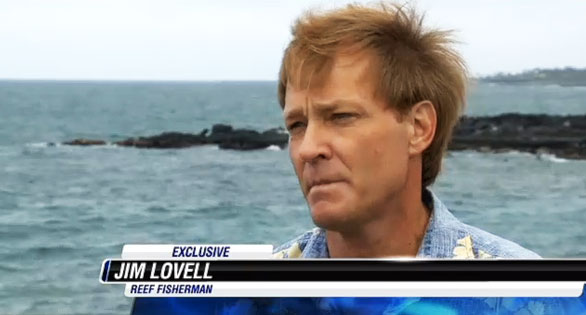
Fisherman Jim Lovell, brother Jay Lovell, claiming that fishermen were afraid of violent tactics used by Sea Shepherd in their Whale Wars confrontations. Screen image: Hawaii News Now.
The Fishermen’s Perspective
Lovell and Terazano were aboard their anchored twin outboard boat when Sea Shepherd arrived at their fishing site about 40 minutes by boat from the harbor on the day of the incident. This is according to Lovell’s brother, Jim Lovell, another aquarium fisherman who has had his fair share of conflict with anti-aquarium fishery activists over the years. Jim Lovell relates the story he says his brother told him. (Because of an ongoing investigation and pending charges, neither of the two fishermen shown in the video is speaking publicly about the incident.)
“Sea Shepherd comes out,” says Lovell. “They target the boat…identify it as an AQ boat. Then they go down the coast just a little bit—you know, just far enough away so the divers aren’t terrified.”
According to Lovell, once the Reef Defense boat was gone, the fishermen donned their SCUBA gear and entered the water. They were fishing a reef at a depth of about 50 feet using a tall net maneuvered as a sort of corral on the bottom. As is common practice in the fishery, they left their boat unattended on the surface.
“As soon as the divers step in the water,” continues Lovell, “the Sea Shepherd boat buzzes back.” Jim Lovell explains that he has been in similar situations, where anti-aquarium activists have approached him underwater.
“It’s scary,” he says. “I’m in an environment where I cannot survive. I have no idea what their intentions are. I know they’re not here to bring me a cup Starbuck’s coffee. They’re there to come after me—they’ve made that clear.”
Lovell says that Sea Shepherd’s engagement in the longstanding debate over the aquarium fishery in Hawaii has taken a more than decade old conflict to a whole new level. He refers to the Whale Wars tactics used by Sea Shepherd and seen by tens of millions of people on cable television. “They blow up boats—they sink boats, they harass people, and threaten to kill people…. These guys are eco-terrorists.”
According to Lovell, when the Reef Defense boat returned to the site where his brother was fishing on May 8th, a number of divers entered the water. Lovell picks up the story there. “All of a sudden [Sea Shepherd] shows back up, they’re all over the place, and of course you can’t fish with anybody near your nets.” He explains that people have to be at least 100 feet away.
“Otherwise you’re affecting the way the fish act,” he says. “You can’t herd fish in your net with a person there.”
Lovell says his brother and Terazano made gestures for the Sea Shepherd divers to back away because they were interfering with fishing efforts. “[The fishermen] are motioning, ‘Hey, Guys, you need to leave. You need to go away,’ but nothing happens.” It was, according to Lovell, a very tense situation compounded by a year of anxiety regarding just such an interaction.
“Jay’s now basically starting to panic,” Lovell says. “What are they doing up above on their boat that they can’t see? Every time they turn their back, it’s like what are they doing behind their back… Jay panicked because he was scared, and he went over and knocked the regulator out of the mouth of the closest person to try to diffuse the situation.”
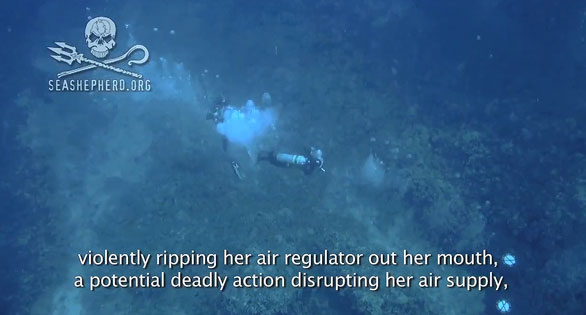
“Attempted murder,” charges Sea Shepherd, who released this image of Rene Umberger’s air regulator being forcibly removed, releasing a cloud of bubbles.
Crossing a Line
A Sea Shepherd spokesperson picks up the story. “As the Sea Shepherd divers approached the coral reef, they came across two other divers poking coral and collecting fish. As they filmed from a distance, one of the collectors noticed the camera from afar and immediately ‘rushed’ diver Rene Umberger without warning, struck her in the nose and pulled the air regulator from her mouth.”
The video footage clearly shows Lovell dislodging Umberger’s regulator.
“The assailant in this violent episode should be charged with attempted murder,” says Sea Shepherd USA Administrative Director Susan Hartland. “This was a completely unprovoked attack. It is legal to have cameras underwater and whatever the collector’s feelings, it does not give him the right to assault anyone. The fish trafficker responsible should be charged and held responsible to the fullest extent of the law. A far less accomplished diver may not have survived.”
Jim Lovell says his brother did not intend to harm Umberger. He says his brother told him, “I didn’t pull her mask off so she couldn’t see her regulator. I didn’t turn her air off. I didn’t grab her. I didn’t touch her. I just knocked the regulator out of her mouth, and that’s the first thing you learn when you get certified—how to put a regulator back in.”
Regardless of his intent, however, most who support the aquarium fishery agree Lovell’s action certainly crossed a line.
The incident remains under investigation, with sources close to the case indicating that charges will be brought against Lovell. A legal expert who spoke under condition of anonymity says that under Hawaii state law, Umberger would need to have been injured in the incident for assault charges to be brought, so it’s more likely a charge of reckless endangerment.
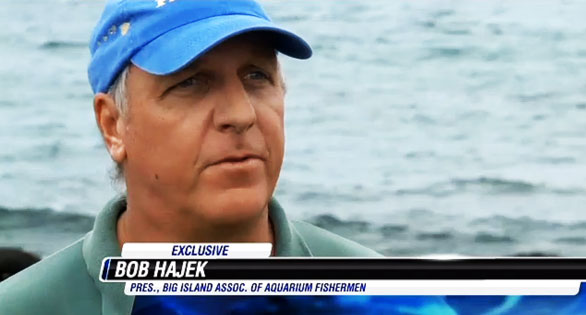
Aquarium fisherman Bob Hajek: he and others would like laws prohibiting interference with their legal fish collection work. Screen image: Hawaii News Now.
Counter Complaint
Jay Lovell filed a counter complaint against Umberger, but it’s unclear if his complaint of harassment will result in charges or a conviction. Lovell says his brother called law enforcement from the boat to report the incident.
Fishermen argue that anyone filming or observing their fishing activity at the distance at which Umberger was when the incident occurred is harassment because it interferes with their “legal, permitted livelihood.” In at least one prior attempt to bring charges of harassment against an anti-trade activist, the charges were dropped because, according to state law, there is no regulation in place specifically against harassment of a fisher in the marine environment. While there is a provision for bringing harassment charges against an individual interfering with freshwater fishing, at this time, marine fishers have no such explicit protection. “There are still ways charges may be brought,” said a source well-versed in state law, “but it’s not as cut and dry as if a similar thing happened in freshwater.”
According to sources, a bill protecting marine fishers from harassment is under consideration and may be introduced during the next legislative session.
“The bottom line is that the law does not protect us,” Jim Lovell says. “[Sea Shepherd] can do this, and there is nothing illegal about it. They can harass us all they want—there’s nothing the State can do. They cannot charge them with harassment unless they start assaulting us.”
For its part, Sea Shepherd says they are not harassing fishermen or intervening in any way. Watson says he doesn’t know if there was illegal activity occurring or not, which is why, he says, Sea Shepherd is investigating. “We’re not a protest organization,” says Watson. “We don’t actually intervene unless it’s illegal. So I think that what you’re seeing [in Hawaii] is an investigation, but there wasn’t any intervention…. We’re not going to be interfering with any legal fishing operation.”
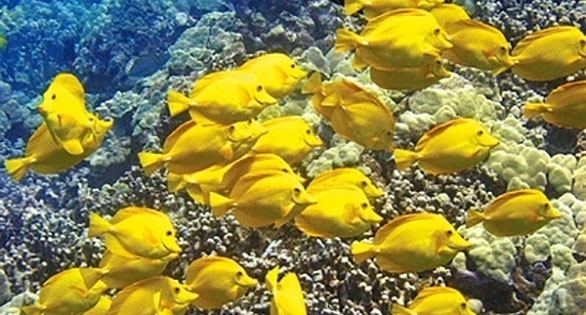
The most-collected species in Hawaii, Yellow Tang are carefully monitored by the Hawaii Division of Aquatic Resources. Image courtesy Bill Walsh, Hawaii DAR.
An Uncertain Future
The timing of Sea Shepherd’s decision to engage in the Hawaii marine aquarium fishery is ironic to some. After all, a major new aquarium-specific rules package that took more than a decade to craft in a massive multi-stakeholder process just became law this year. Fisheries managers maintain the West Hawaii Aquarium Fishery has by far the most comprehensive management of any fishery in Hawaii, including 35% protected areas, limited species list (aka, “white list”), bag limits on several important species and life stages, catch report requirements, permit and vessel registration requirements, and other regulations. Upwards of 90% of the current harvest in the West Hawaii aquarium fishery are comprised of only two species, and since no-take zones (aka Fishery Replenishment Areas) were established, studies have shown that populations of both of these species have increased.

Dr. William Walsh, marine biologist at the Hawaii Division of Aquatic Resources: Using good science to create rules and regulations for a sustainable aquarium fishery.
Recent studies also show the most-heavily fished species, Yellow Tang (Zebrasoma flavescens), is in good shape along the Kona coast of the Big Island, site of the State’s largest aquarium fishery. Several articles in peer-reviewed scientific journals over the past year have looked at how sustainable aquarium fisheries actually have positive conservation outcomes.
As state fisheries biologists and others in the conservation movement in Hawaii have contended for years, other anthropogenic stressors beyond the aquarium fishery (such as shoreline development and agro-chemical pollutants reaching the sea) are having a much greater effect on reef ecosystems, yet few people are taking the same sort of passionate approach to those issues.
An aquarium fishery, like any fishery, must be well managed. There are many sane minds interested in seeing a healthy AQ fishery stabilize in Hawaii, and they all agree that management of reef resources works best when it is based on data and not emotion. Ironically, they say, we have more data showing sustainability in Hawaii’s aquarium fishery than in other less studied and potentially more damaging food and sport fisheries, yet the anti-aquarium trade movement, now joined by Sea Shepherd, remains focused on the aquarium fishery.
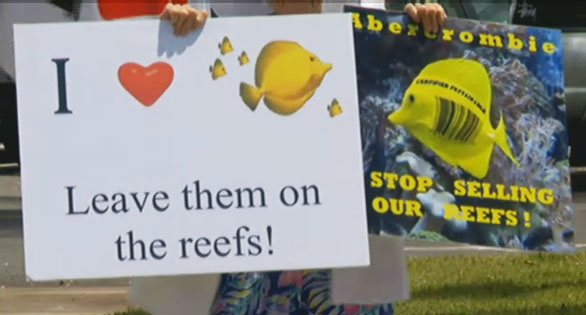
Anti-aquarium activists in 2012 protest the selling of Yellow Tangs and other reef fishes collected in Hawaiian waters. Screen image, Hawaii News Today.
This recent incident may either be an isolated event or the first episode in an entirely new kind of battle over Hawaii’s aquarium fishery. Most stakeholders interviewed for this article agree that what happened in the water between Lovell and Umberger is serious—deadly serious—and they agree it should be addressed as such through legal means.
But, many say, the bigger picture must also be addressed, and the first step in ensuring a sustainable future is to tone down the rhetoric and focus on the data. It’s unclear, however, how successful such an approach will be as long as polarizing anti-trade activists like Umberger and Wintner employ their tactics under the Sea Shepherd flag.
About the Author
Ret Talbot is a senior editor of CORAL Magazine who frequently writes about sustainability issues in the aquarium livestock trade. He writes the Good Catch Blog and lives with his wife Karen on the coast of Maine.
Sources
New Rules for Hawaii’s Big “AQ” Fishery, by Ret Talbot, December 13, 2013. Reef2Rainforest.com
ABC News Report: Hawaii Scuba Divers Face off Over Aquarium Fish May 15, 2014
YouTube Video Interview with Robert Wintner: by Carolyn Harding.
Protecting Yellow Tang, The Honolulu Advertiser, May 17, 2014.
FURTHER READING
West Hawaii’s White List (2013) of Allowable Aquarium Species, by Ret Talbot, December 16, 2013. Reef2Rainforest.com
An Aquarist’s Notes: Turbulence in Hawaii
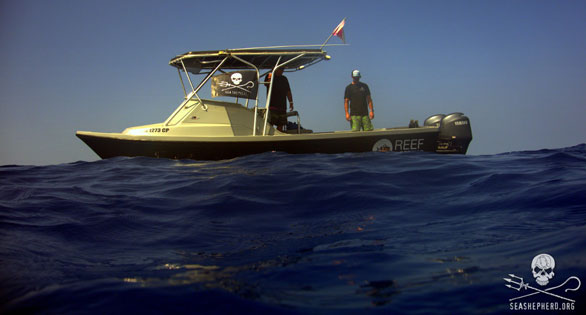
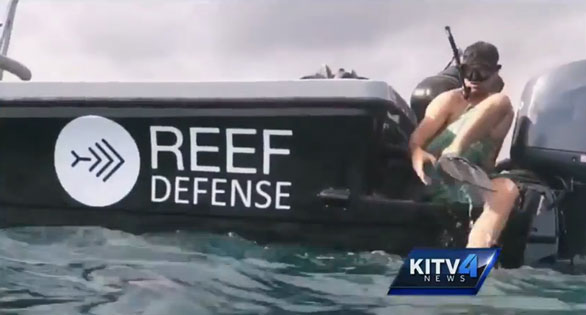





Thanks for setting the record straight.
Has the authorities thought to investigate the Sea Shepherd boat for coming into the exclusion zone of a vessel flying a divers below flag? This is very dangerous and illegal behavior putting the divers bellow in great danger if they were to be surfacing. Other peoples safety is something Sea Shepard Grubs seem to disregard frequently when a headline beckons.
This is what can happen when misinformed people act on their own beliefs without knowing the actual facts. Sea Shepard needs to accept the fact that educated scientists know more than they do when it comes to sustainable fish populations around the Hawaian islands. Hopefully this so-called group of sea gaurdians are prosecuted for their actions.
As a tropical fish hobbyist, the actions of Sea Shepard are interfering with the aquarium fishermen’s livelihood and while I don’t support the diver’s actions against Rene Umbreger were out of bounds, I can see where the AQ diver is coming from. What does it take for guys like Snorkel Bob and Sea Shepard to understand that aquarists seek to preserve reefs as well. Without reefs, we wouldn’t have to beautiful fish we enjoy in our hobby. Furthermore, THERE IS SCIENTIFIC PROOF STATING THAT AQ FISHERMEN’S ACTIONS ARE SUSTAINABLE!! I hope that these misinformed organizations come to their senses before this situation escalates to the point that lives are lost.